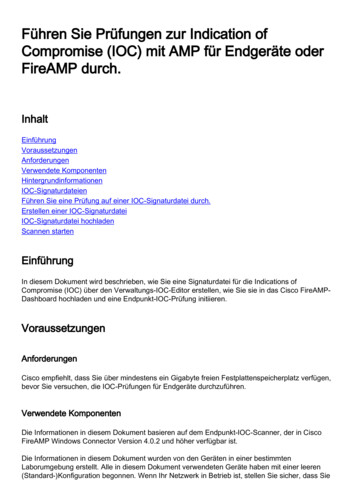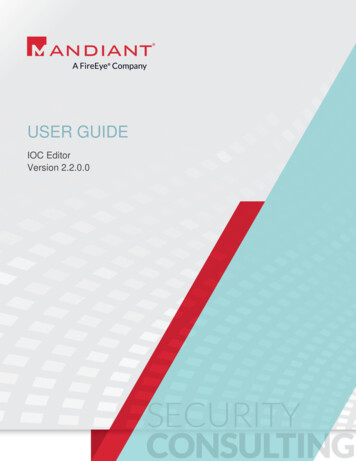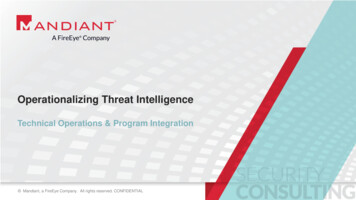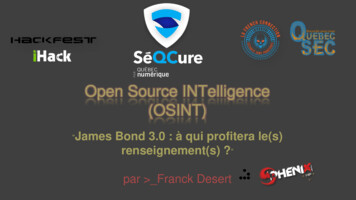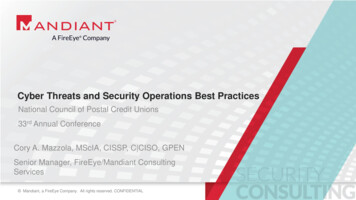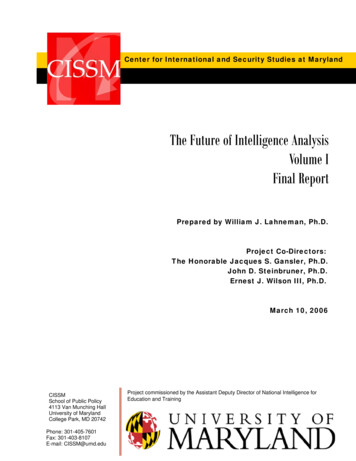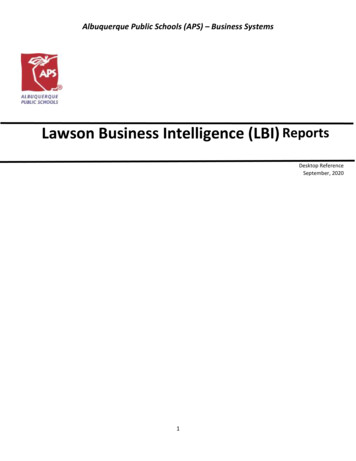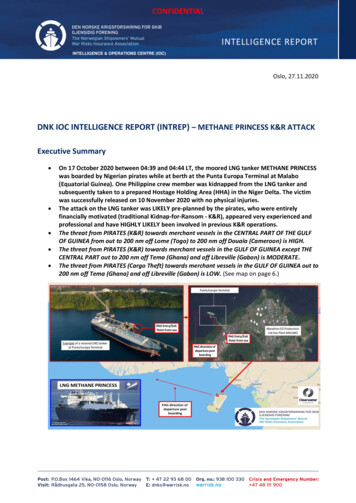
Transcription
CONFIDENTIALINTELLIGENCE REPORTINTELLIGENCE & OPERATIONS CENTRE (IOC)Oslo, 27.11.2020DNK IOC INTELLIGENCE REPORT (INTREP) – METHANE PRINCESS K&R ATTACKExecutive Summary On 17 October 2020 between 04:39 and 04:44 LT, the moored LNG tanker METHANE PRINCESSwas boarded by Nigerian pirates while at berth at the Punta Europa Terminal at Malabo(Equatorial Guinea). One Philippine crew member was kidnapped from the LNG tanker andsubsequently taken to a prepared Hostage Holding Area (HHA) in the Niger Delta. The victimwas successfully released on 10 November 2020 with no physical injuries.The attack on the LNG tanker was LIKELY pre-planned by the pirates, who were entirelyfinancially motivated (traditional Kidnap-for-Ransom - K&R), appeared very experienced andprofessional and have HIGHLY LIKELY been involved in previous K&R operations.The threat from PIRATES (K&R) towards merchant vessels in the CENTRAL PART OF THE GULFOF GUINEA from out to 200 nm off Lome (Togo) to 200 nm off Douala (Cameroon) is HIGH.The threat from PIRATES (K&R) towards merchant vessels in the GULF OF GUINEA except THECENTRAL PART out to 200 nm off Tema (Ghana) and off Libreville (Gabon) is MODERATE.The threat from PIRATES (Cargo Theft) towards merchant vessels in the GULF OF GUINEA out to200 nm off Tema (Ghana) and off Libreville (Gabon) is LOW. (See map on page 6.)
CONFIDENTIALBackground(DNK Sources) On 17 October 2020 between 04:39 and 04:44 LT, the moored and fully laden MarshallIsland-flagged LNG tanker METHANE PRINCESS was boarded by five armed pirates while at berth at thePunta Europa Terminal at Malabo (Equatorial Guinea) and while involved in disconnecting operations.(DNK Sources) The Pirate Action Group (PAG) consisted in total of nine pirates arriving from sea undercover of darkness in a black colored fiberglass skiff (10-11 meters in length) with two large outboardengines and a long aluminum ladder. The skiff was kept along a floating jetty/boat landing (see Entry/Exitpoint from sea at picture on page 1) below and at the end of the main terminal jetty during the boarding.An unlocked gangway took five of the pirates up to the main jetty. The five pirates were armed with onerusty and badly maintained double-magazine AK-47 assault rifle each and dressed in dark clothing (logsleeve jackets) all being bare-footed. The five pirates quickly took control of two unarmed portemployees near the gangway bridge involved in the disconnecting operations. The pirates then enteredthe LNG tanker via this gangway with the two port employees. The five pirates later tried to enter theaccommodation of the LNG tanker, but did not succeed as it was partly locked down.(DNK Sources) Two minutes after the pirates having entered the LNG tanker, the onboard alarms weresounded and the five pirates panicked and made way for the gangway with in total three hostages, twobeing local port employees and oneLNG crew member of Philippinenationality being the upper decksecurity watch. While running downthe narrow gangway towards themain jetty one of the portemployees started to fight one ofthe pirates, resulting in the portemployee jumping or falling off thegangway. The pirates left him behindand continued with now twohostages. The remaining crewonboard the LNG tanker continuedwith their lockdown procedure andcalling local security for assistance. The five pirates left the LNG tanker less than five minutes after havingentered the tanker.(DNK Sources) When the five pirates with now two hostages arrived at the waiting skiff containing fourmore pirates onboard, they quickly embarked and headed for open water still under cover of darkness.As the PAG was departing the LNG terminal, the second of the port employees managed to jump out ofthe skiff and into the water and escaped. No shots were fired during the operation. The port employeejumping or falling off the gangway was quickly treated for his injuries inside the accommodation. Theport employee jumping off the pirate skiff was treated for injuries by Equatorial Guinea security forceswhich arrived at the scene one hour and four minutes after the alarm was raised by the LNG tanker.(DNK Sources) The LNG tanker departed according to plans and port approvals, the same day for herplanned destination.(DNK Sources) The PAG transited at high speed towards Nigeria partly during light hours with theabducted crew member laying down in the bottom of the skiff covered by a tarpaulin. The PAG stoppedseveral times in the open water close to smaller fishing vessels, asking for the direction towards a costallocation in Rivers State (Nigeria). The PAG arrived in vicinity of this location three-four hours afterdeparting the LNG Terminal.Side 2/7
CONFIDENTIAL(DNK Source) The PAG then entered the river system and continued inland using smaller rivers/creeksthroughout the first day and waited for darkness. After darkness a smaller skiff arrived, and the victimwas transferred into this skiff with other pirates onboard, having a single engine and being seven-eightmeters in length. Both skiffs continued for less than 30 minutes before arriving at a location which wasprepared as a Hostage Holding Area (HHA).(DNK Sources) The HHA was managed by a dedicated Guard force consisting of seven perpetrators,which rotated being 24/7 guards on duty (always two persons), fishing and resting. The Guard force, notbeing the same as the pirates conducted the abduction, had double-magazine AK 47 assault rifles ofsame poor standard as the PAG, and were more or less constantly abusing lighter drugs. In addition tothe Guard force, the Gang leader and the pirate negotiator occasionally attended the HHA. There wereno other hostages observed in the HHA during the obduction period. The victim was treated relativelywell with access to food and water. The victim stayed in the same small house as the Guard force duringhis stay in the HHA. The victim was not exposed to violence.(DNK Sources) On 10 November 2020, 24 days after being kidnapped, the victim was successfullyreleased in Rivers State. The victim was later repatriated successfully to the Philippines.DNK IOC Comment(Open Sources/Vesseltracker - AIS) The Punta Europa LNG terminal is only visited by LNG tankers thatexport Liquefied Natural Gas (LNG). Since the beginning of April 2020, in average one LNG tanker hasbeen moored at the LNG terminal every 12-13 day for loading operations, which lasted up to 48 hoursdepending on the size of the LNG tanker. This means that the LNG terminal has had a moored tanker forLNG loading maximum 14 % of an average month since April 2020.(DNK Source) The LNG terminal was fully illuminated, and the two terminal employees were busydisconnecting hoses, as the loading had been completed. At the time of the attack, there were nosecurity boats next to the LNG terminal nor any security personnel present at the jetty. And according toterminal regulations, the LNG tanker’s radars were not operational during the loading operation.(DNK Source) The two terminal employees managed to alert the EG LNG control (Duty Watch) of whatwas happening when the PAG arrived at the Entry Point at the jetty, about two minutes before thepirates embarked the tanker. However, the tanker was not alerted quickly enough by the EG LNGControl, as VHF towards the LNG tanker was not a sufficient means of communications at that time.DNK IOC AssessmentThe perpetrators’ motivesAs there were no mentioning of any political claims, statements or interest by any of the pirates, they areHIGHLY UNLIKELY to be linked directly to any militant branches (Insurgent Groups) that exists in theNiger Delta region, which are focusing on getting a more local involvement in the export and productionof hydrocarbons, according to their perception that Nigeria is being looted of its wealth by foreigncompanies.The motives of the pirates were entirely financially related and is therefore categorized as traditionalGoG Piracy; Kidnap-for-Ransom (K&R).Side 3/7
CONFIDENTIALThe perpetrators’ organization, capabilities and Tactics, Techniques, and Procedures (TTP)The pirates involved in the LNG tanker K&R operation, were divided into two gangs; one gang (the PAG)conducting the kidnap consisting of nine pirates, and one separate gang consisting of seven piratesorganizing the Hostage Holding Area (HHA) in the Niger Delta. In addition, a leader and a negotiator werepart of the set up. Specialized and loosely connected individuals and gangs “buying services” from eachother, is increasingly common within the Niger Delta piracy networks and the Nigerian maritime K&Rmodel.The skiff used by the PAG had two big Yamaha engines and had at least 20 plastic cans of petrol sized 50liters onboard. The majority of previous attacks in the GoG have been conducted by one skiff powered byone 3 cyl engine of around 70-80 bhp and a one V6 engine 150-200 bhp LIKELY acting as a booster forincreased speed when required. The skiff used in the LNG tanker attack had a different engineconfiguration, indicating that this PAG LIKELY was aiming to kidnap a higher number of crew, and stillhave the capability to travel at high speed for a prolonged time/distance. The skiff used is LIKELY thesame skiff that was used during the attack on SENDJE BERGE on 2 July 2020, and thereof the same PAG.The extraction from the terminal and voyage towards the Rivers State took place at high speed and in anaimed straight line. In previous GoG K&R cases the pirates have used a hand-held Thuraya satcom as anavigation aid. During this extraction voyage no such device was used. The pirates had one individualsitting up front scouting for potential Navy or security vessels, and they only stopped close to smallerfishing vessels asking for direction for a known land feature in Rivers State. They made no attempt tosteal anything from the smaller fishing vessels like fuel or valuables, so they HIGHLY LIKELY knew thedistance, and that they had calculated that they had enough fuel. The PAG was further HIGHLY LIKELYaiming to maintain a low-key posture, and not attract further attention towards themselves in waterswith numerous security vessels.The Commander of the Hostage Holding Area (HHA) and the negotiator are LIKELY well-establishedcharacters in the Niger Delta piracy networks and were LIKELY involved in the SENDJE BERGE case in July2020 amongst other cases throughout 2019 and 2020. The area the HHA was located within, has HIGHLYLIKELY also previously been used to organize HHAs both for holding hostages from maritime K&Roperations, but also for holding hostages from land-based K&R operations. Hence an experienced andprofessional Nigerian K&R network with operational roots from a well-established pirate sanctuary inRivers State, was HIGHLY LIKELY behind the LNG tanker K&R attack on 17 October 2020.Both the PAG that conducted the boarding and abduction of the crew from the LNG tanker, and thepirates organizing the HHA, appeared very experienced and professional and have HIGHLY LIKELY beeninvolved in previous K&R operations.Side 4/7
CONFIDENTIALThe perpetrators’ targeting processAs potential targets for pirates on the LNG terminal only have been available maximum 14 % of anaverage month since April 2020, leaves a K&R operation - by chance/ad hoc basis - towards the LNGterminal with a 86 % probability of failure - only taking lack of targets in to consideration and notconsidering impact by local security measures increasing the probability of failure further.Nigerian PAGs have previously been very adaptable to counter local security measures. On 9 May 2019around 03:00 LT, the Comoros-flagged general cargo vessel RIO MITTONG was attacked by a PAG atMalabo anchorage only 3 nm (5,5 km) from the Punta Europa LNG Terminal, and this location was evencloser to the security vessels that are based in Malabo port. During this incident two crewmembers werekidnapped by five perpetrators that boarded RIO MITTONG.In previous successful maritime K&R attacks towards merchant vessels in GoG, a ladder has been usedfor boarding the target vessel. During the LNG terminal attack no ladder was used, despite one longaluminum ladder was carried in the skiff, LIKELY because the ladder was a reserve boarding option.The facts that the whole operation from arrival to departure was completed very swiftly, that theterminal entry and exit happened during complete darkness, that a LNG terminal should be expectedhaving tight security, that targets only are available 14 % of a month and that the attack occurred duringloading (even if it occurred on the finale stage) when there usually are several people within reach forpirates on deck are combined strongly consistent with a hypothesis that this operation was pre-planned.It is therefore LIKELY that this PAG had intelligence on the LNG terminal and that a tanker was alongsidefor loading, and on routines, weaknesses and response time of the local security forces, either througheyes-on-target and/or other sources.The attack on the LNG tanker was LIKELY pre-planned by the pirates.Side 5/7
CONFIDENTIALThreat forecastSee also DNK IOC Monthly Threat Assessment December 2020 when distributed 30. November 2020: The threat from PIRATES (K&R) towards merchant vessels in the CENTRAL PART OF THE GULFOF GUINEA from out to 200 nm off Lome (Togo) to out to 200 nm off Douala (Cameroon) isHIGH.The threat from PIRATES (K&R) towards merchant vessels in the GULF OF GUINEA except THECENTRAL PART out to 200 nm off Tema (Ghana) and off Libreville (Gabon) is MODERATE.The threat from PIRATES (Cargo Theft) towards merchant vessels in the GULF OF GUINEA out to200 nm off Tema (Ghana) and off Libreville (Gabon) is LOW.Side 6/7
CONFIDENTIALStandardisationThe threat: The threat assessed by DNK IOC, is based on our understanding of known threat-actors' capabilities,hostile intentions and their opportunities to cause harm/hostility directly towards vessels/units and their crewtoday and in the future, limited to defined areas. The threat could also be of an indirect nature, caused as collateraldamage when vessels/units plausibly could be affected by an attack by mistake or by coincidence.Words of Estimative Probability (Confidence Levels): Words of estimative probability (WEP) are terms used toconvey the likelihood/probability of a future event occurring. In this product, the following WEPs are used:HIGHLY LIKELY - LIKELY – (EVEN CHANCE) - UNLIKELY - HIGHLY UNLIKELYThreat Levels: Threat levels are designed to conclude the assessment of each threat. In this product, the followingThreat Levels are used (NATO and Norwegian standards) with the defined level of probability/confidence: LOW means attack against member vessel is UNLIKELYMODERATE means attack against member vessel is LIKELYHIGH means attack against member vessel is HIGHLY LIKELYCRITICAL means attack against member vessel is expected imminentlyA Threat Assessment should not be mistaken as a Security Risk Assessment. DNK IOC does not consider each vesseland their vulnerabilities, nor risk mitigation measures taken or not taken by the member. The Threat Assessmentshould however, be understood as an input to our member’s Security Risk Assessments processes.The DNK IOC Threat Assessment is valid only from the date of dissemination and until a revised Threat Assessmentis disseminated by DNK IOC. Out-dated Threat Assessments should never be used as inputs to Security RiskAssessments or as any kind of decision support on Security matters.Specifications and Contact detailsInformation Cut-Off: 27. November 2020 0600 UCTIntelligence & Operations Centre (IOC) 24/7 Contact details:Duty Officer e-mail: current.intel.ops@warrisk.no Duty Officer Office: 47 22 93 68 30 Duty Officer Mobile: 47 48 111 900 Duty Officer SATCOM: 88 16777 06404 Crisis & Emergency Number: 47 48 111 900CaveatsThis Intelligence product is Confidential and shared in confidence: Feel free to share the Intelligence product, butonly within your organization. Do not post the Intelligence products on the www. If you are to refer to elementsfrom the Intelligence products, please quote accurately and give reference to DNK IOC – to avoid Intelligence loops.This report has been compiled from multiple sources. DNK does not accept responsibility for verifying informationprovided in this document, nor for the outcome of action taken or not taken as a result of information provided,our comments and/or advise.The DNK Intelligence and Operations Centre (IOC)The Intelligence & Operations Centre (IOC) at DNK (Norwegian Shipowner's Mutual War Risks InsuranceAssociation), builds the global Intelligence picture to support decision making amongst our members in the short tolong term. We do this through a professional set-up consisting of an extended source-network and skilledIntelligence analysts. DNK IOC also support our members with Crisis Management if necessary.Side 7/7
INTELLIGENCE & OPERATIONS CENTRE (IOC) CONFIDENTIAL DNK IOC INTELLIGENCE REPORT (INTREP) -METHANE PRINCESS K&R ATTACK Executive Summary On 17 October 2020 between 04:39 and 04:44 LT, the moored LNG tanker METHANE PRINCESS was boarded by Nigerian pirates while at berth at the Punta Europa Terminal at Malabo
